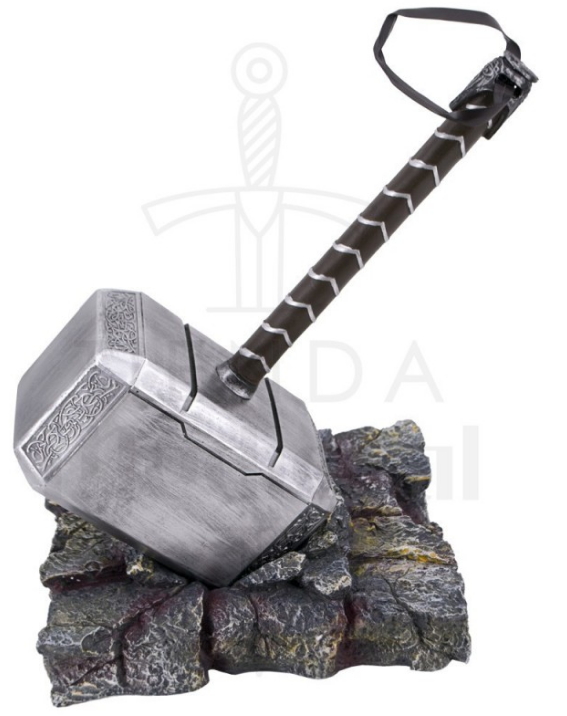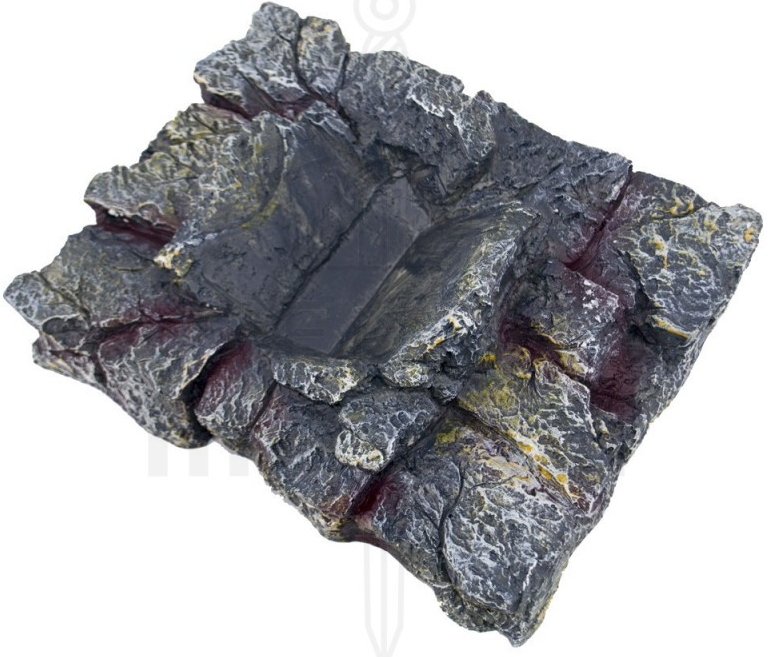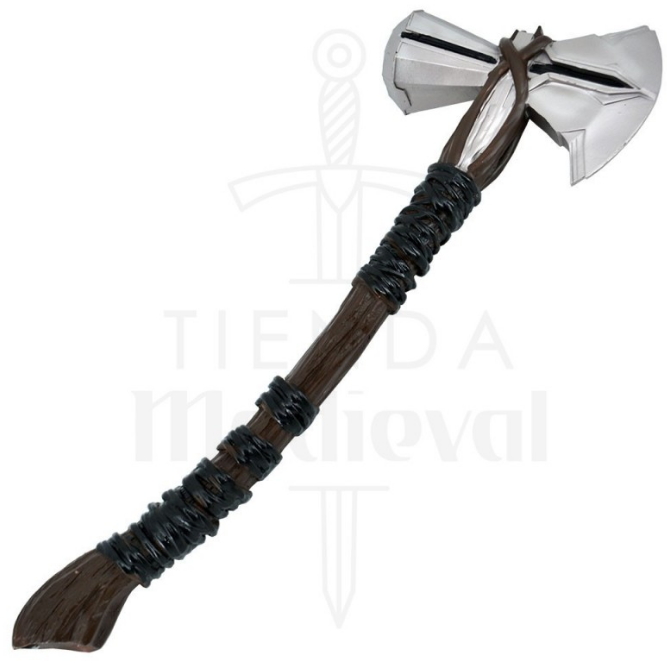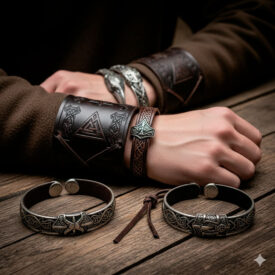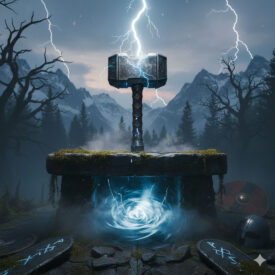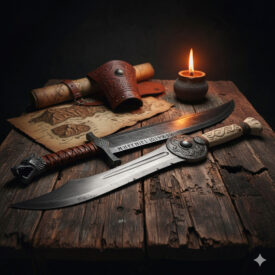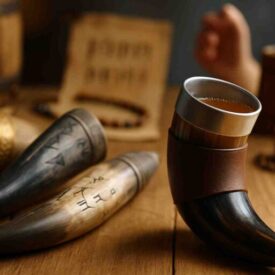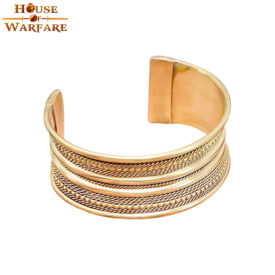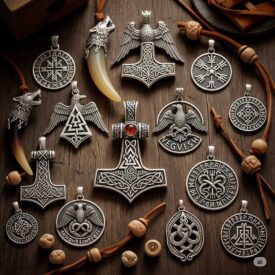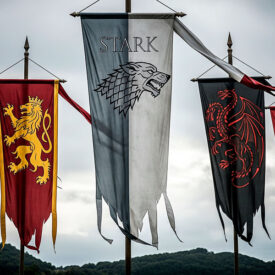In Norse mythology exists a weapon that summarizes the strength, protection, and ritual vocation of an entire people: Mjolnir, Thor’s legendary hammer. This symbol has traveled from Viking sagas to modern cinema halls, becoming a recognizable emblem worldwide. In this article, you will discover its origin, its traditional powers, its role in Viking rituals, the most relevant mythical stories, its transformation in popular culture, and how its legacy has remained alive to this day.
Where does Mjolnir come from? The origin of the hammer
The forging of Mjolnir is, in itself, one of the most celebrated stories in Norse mythology, exemplifying the tone of rivalry, humor, and danger that runs through the Eddas. The sequence begins with Loki, the mischievous god, who, by prank or malice, cuts the hair of Sif, Thor’s wife. To avoid the thunder god’s wrath, Loki resorts to the dwarf gods and proposes a bet that will end up producing several wonderful treasures.
The dwarf brothers Brokkr and Sindri (also known as Eitri) accept the challenge. During the forging, Loki transforms into a fly to sabotage the work, biting Brokkr and causing a small interruption in the bellows. That minimal flaw is what explains why Mjolnir’s handle turned out short. Even so, when the treasures are presented to the gods, Mjolnir is unanimously declared the masterpiece: relentless, imposing, and with a power that surpasses that of any other artifact created by mortal or divine hands.
Elements of the legend
- Gullinbursti: the boar with golden bristles emerged from the forge.
- Draupnir: Odin’s ring that magically multiplied his wealth.
- Mjolnir: the hammer, born imposing but with a short handle.
What did Mjolnir mean to the ancient Vikings?
Mjolnir was not just the weapon of a warrior god; it was a multifaceted symbol used daily in Viking religious and social life. Its presence appears in amulets, carvings, and rituals ranging from birth to burial.
Social and religious functions
- Protection: Warriors sought Thor’s blessing for battle; the hammer was a talisman against evil.
- Purification: Associated with the idea of purity (some etymologies connect Mjolnir with “white snow”), the hammer was used in ceremonies to cleanse or sanctify.
- Fertility: At weddings, the hammer acted as a seal of fertility and family continuity; in some customs, a symbol of the hammer was placed in the bridal bed.
- Consecration: Mjolnir served to sanctify bonfires, homes, and funeral pyres.
These uses show that Mjolnir, more than a weapon, was a ritual tool that represented order against chaos, protection against threats, and continuity against social rupture.
The powers and attributes attributed to Mjolnir
In the sagas, Mjolnir is described with qualities that make it an almost unparalleled weapon:
- Automatic return: Like a divine boomerang, the hammer always returned to Thor’s hand, no matter the distance it was thrown.
- Weather control: Mjolnir allowed Thor to summon lightning and thunder; the sound of thunder was interpreted as the blows of his hammer against the giants.
- Strength multiplier: The hammer amplified Thor’s strength, even though he was already physically powerful.
- Indestructibility: Mjolnir was said to be unbreakable and unable to be damaged by common forces.
Furthermore, in the stories, complementary elements are mentioned: the Megingjörd (belt of strength) and the Járngreipr (iron gloves), necessary for Thor to effectively handle the hammer given its short handle and immense power.
Mythical tales where Mjolnir is the protagonist
Norse sagas are full of episodes that show Mjolnir’s importance. Two of the best known are its theft by Thrym and its role in Ragnarok.
The theft by Thrym
Thrym, king of the giants, stole Mjolnir and demanded Freya as his wife in exchange. The gods, deprived of their most powerful weapon, planned to recover the hammer through a stratagem: Thor disguised himself as Freya, and Loki accompanied him as a servant. During the false wedding, when the hammer was brought to sanctify the union, Thor recovered it, unleashing a massacre among the giants. This story illustrates both Mjolnir’s ritual value (its use for sanctification) and its destructive power when Thor wields it.
Mjolnir and Ragnarok
In the final battle that ends the world, Thor confronts Jörmungandr, the Midgard serpent. He manages to kill the creature with Mjolnir but succumbs shortly after to the beast’s venom. Later versions of the tradition say that Thor’s sons, Modi and Magni, survive and inherit the hammer, symbolizing the continuity of order after the cataclysm.
From iron forge to Uru: transformation in modern culture
The original mythology places Mjolnir’s raw material in iron forged by dwarves. Modern popular culture, especially Marvel comics, reinterpreted the material as Uru, a mystical Asgardian metal forged in the heart of a star. This reinterpretation enhances its magical character and adds layers of fantastic narrative: capacity to store energy, connection to the wielder’s nobility, and technological resonances that fit the superheroic universe.
Mjolnir in popular culture: comics, cinema, and reinterpretations
Thanks to Marvel, Mjolnir has reached massive audiences. In that universe, the hammer retains classic attributes (return, energy control, indestructibility) but also incorporates the enchantment of “worthiness”: only those who are “worthy” can lift it. This narrative license has produced memorable scenes in comics and movies and has served to explore themes such as humility, responsibility, and nobility of spirit.
The film Thor (2011) —with a highly impactful premiere and box office success— popularized the modern image of the god and his weapon. The cinematic saga continued to expand the myth, introducing plot variations (e.g., different characters wielding Mjolnir) and making it a recognizable pop icon for audiences who may be unfamiliar with the original Norse sagas.
Archaeology and amulets: Mjolnir outside the sagas
Numerous hammer-shaped amulets have been found in Viking excavations, confirming Mjolnir’s daily use and popularity among Norse peoples. These pendants vary in size and style, some finely worked in silver, others cruder in bronze.
Hammer amulets frequently appear in male and female burials, suggesting their symbolism transcended gender. Unlike some contemporary Christian symbols that represented faith, Mjolnir amulets showed a practical religiosity: protection in battle and blessing in civilian life.
How to identify replicas and historical pieces
- Material: historical pieces are usually bronze or silver; modern replicas may use steel, resin, or modern alloys.
- Patina and wear: natural aging and burial marks are difficult to convincingly fake.
- Proportions: classic Viking designs tend to be simple and functional; modern replicas sometimes exaggerate ornaments or incorporate anachronistic elements.
Replicas and purchases: where to get a Mjolnir today
If you are interested in an authentic replica or a piece inspired by Mjolnir, our online store offers models ranging from discreet amulets to full-size reproductions with resin bases. Buying from the online store allows you to ensure authenticity, material quality, and manufacturing guarantees.
Tips for choosing a replica
- Decide the purpose: are you looking for a pendant, a display piece, or a utility item for historical recreation?
- Materials: for everyday use, silver or stainless steel are suitable; for decoration, resin or painted metals can offer greater detail at a lower price.
- Size and weight: if you are looking for a display replica, consider a short handle and a solid body that convey realism.
Symbolic interpretations today
Today, Mjolnir is an emblem with multiple interpretations: from an icon of Norse cultural pride to a personal protection amulet. In modern pagan communities, it is a symbol that connects its wearers to pre-Christian traditions and reconstructive rituals. In fashion and collecting, its image has become globalized, turning into an aesthetic icon associated with strength and resilience.
Cultural debates
The contemporary use of Norse symbols sometimes sparks debates about cultural appropriation or improper political use. It is important to distinguish between historical appreciation, respectful cultural recreation, and uses that seek to instrumentalize these symbols for exclusive purposes. Understanding the historical context helps to correctly value an emblem like Mjolnir.
Frequently asked questions
Can only the worthy lift Mjolnir? In the original mythology, that enchantment does not exist. The idea of “worthiness” comes primarily from Marvel and has been a very effective narrative device, but it is not an explicit condition in the classic Eddas.
Are we dealing with a real weapon? Mjolnir is a mythical concept based on the forging of the dwarves; there is no evidence of a real magic hammer, but there are amulets that reflect the importance of the symbol in real life.
What Mjolnir tells us today
Beyond its narrative spectacle, Mjolnir embodies values that continue to resonate: the defense of order, the search for protection for the community, and the need to ritualize the fundamental steps of human life (birth, marriage, death). Its persistence in modern culture demonstrates the power of symbols and their ability to adapt to new languages without losing their core identity.
VIEW THOR GOD HAMMER | VIEW MORE THOR PRODUCTS | VIEW MORE PERIOD HAMMERS
Mjolnir continues to strike our imagination: from the smoke of Viking pyres to the cold light of the cinema screen, its silhouette recalls the relationship between men, their fears, and their desires for protection. Wearing its image, studying it, or reproducing it is to participate in a dialogue that spans centuries and can still teach us much today about how we create and recreate symbols to understand the world.

